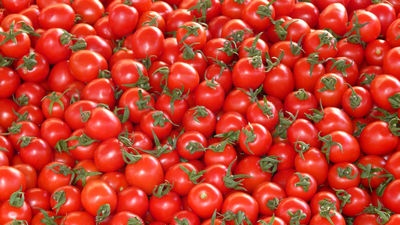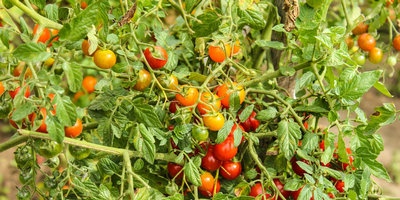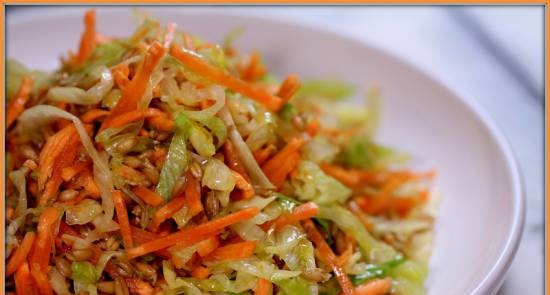|
 To obtain an early and high yield of tomatoes, the correct choice of site in the crop rotation field is of great importance. The best place to plant tomatoes is on a southern slope, where the groundwater is deep. To obtain an early and high yield of tomatoes, the correct choice of site in the crop rotation field is of great importance. The best place to plant tomatoes is on a southern slope, where the groundwater is deep.
The earliest ripening and high yields of tomatoes can be achieved on light cultivated soils.
The best places for tomatoes in a crop rotation are areas that have come out of cabbage and cucumbersas well as perennial herbs.
In order to combat diseases, tomato culture can be returned to its original place only after 3-4 years. But tomatoes cannot be placed after crops from the nightshade family (potatoes, eggplants, peppers).
a) The highest yields of tomatoes are obtained with the simultaneous use of organic and mineral fertilizers.
On old-arable soils, well-filled with organic fertilizers, it is recommended to apply mineral fertilizers per hectare in an amount: ammonium sulfate — 1.5—2.25 c, superphosphate — 2.5—3.25 c and potassium 4O% salt — 1.5 —2.25 q or 5—6 q of wood ash.
In addition to mineral fertilizer, humus is applied during planting in an amount of 10-15 tons per hectare, that is, 500-750 g for each plant.
On soils poorly fertilized with fertilizers in previous years, under tomatoes should be applied: 3-4.5 centners of ammonium sulfate, 5-6 centners of superphosphate and 2.25-3.0 centners of potassium salt, or 6-8 centners of wood ash.
In addition to mineral fertilizers, organic (humus) must be applied in the amount of 15–20 tons per hectare, 750–1000 g for each plant in the holes.
 The main (mineral) fertilizer is applied in the spring for plowing. The main (mineral) fertilizer is applied in the spring for plowing.
b) The size of the total yield, especially the yield of ripe fruits and the period of their ripening, largely depends on the quality of the seedlings. Seedlings of good quality have a dark green color of tops, a thick, low stem of 20-25 cm, 8-10 leaves and buds of the first flower cluster.
Sowing tomatoes should be done 50-60 days before planting in the ground. Tomato seeds, 2-3 days before sowing in greenhouses, should be disinfected with mercuric chloride in a solution — 1 part mercuric chloride per 3000—5000 parts of water or in a formalin solution — 1. part 40 ° / e formalin to 300 parts of water. The feeding area for seedlings in greenhouses is set at 8X8 cm. At the same time, 250-300 pieces of roots can fit under one greenhouse frame.
In order to obtain early production and painless transplantation of seedlings from greenhouses into the ground, seedlings are grown in peat-manure pots with a diameter of 10 cm or in sod 10X10 cm.
When forcing seedlings, the following regime is recommended in greenhouses: temperature 18–20 °, good ventilation, timely shelf and keeping greenhouses clean.
When growing seedlings, it is necessary to adjust the plants by feeding with full mineral fertilizer. The concentration of the fertilizer solution is as follows: for 1 bucket (10 liters) of water, 20-25 g of ammonium sulfate or 14-16 g of ammonium nitrate, 14-16 g of superphosphate and 8-10 g of potassium salt are taken. One 10-liter bucket of solution is consumed per 1 frame of the greenhouse. With a weak development of seedlings, watering must be repeated 2-3 times, and the first watering is carried out 5 days after the pick. To accustom greenhouse seedlings to open field conditions, it is necessary to gradually harden the plants. With the onset of warm weather, the frames are removed for the day, and on warm nights they are slightly opened.
The term for planting seedlings in open ground for all regions is determined by the end of the last spring frosts. To obtain an early harvest, in all areas it is recommended to plant an earlier planting on a part of the area, 10-12 days before the main planting, using measures to combat frost: the installation of protective barriers on the north and north-east sides and smoke screens.
Tomato seedlings must be planted in the ground with a lump of earth, and if they were grown in adobe pots, then together with a pot.
Particular attention should be paid to the careful handling of the seedlings at the time of planting.When transported in the field and before disembarkation, the seedlings should be well moistened and protected from the action of sunlight and wind. Seedlings taken to the field should be planted on the same day. When planting, do not allow damage to the stems, leaves and flower brush. After planting, the plants are immediately watered and the watered areas are covered with dry soil in order to conserve moisture and protect them from crusting. If the soil is not sufficiently moist, watering the holes should precede planting, and after planting, watering should be repeated on the second and third day.
Depending on the degree of soil moisture, the rate of water consumption during irrigation ranges from 0.7 to 1.0 liters per plant. The seedlings are planted in the ground a little deeper than they were in the greenhouse. After 2-3 days after planting, the site is checked and, in the event of a lunge (non-accepted plants), replanting is carried out now.
 As a rule, a field with a flat surface is allocated for tomatoes. The site is marked along and across, after which holes are dug out. On heavy soils, especially in the northern regions, planting should be done on ridges. For single- and double-stemmed plants, the feeding area in row spacings is 70 cm, in rows 35–40 cm; for multi-stemmed - in row spacing 70 cm, in rows - 50-60 cm. As a rule, a field with a flat surface is allocated for tomatoes. The site is marked along and across, after which holes are dug out. On heavy soils, especially in the northern regions, planting should be done on ridges. For single- and double-stemmed plants, the feeding area in row spacings is 70 cm, in rows 35–40 cm; for multi-stemmed - in row spacing 70 cm, in rows - 50-60 cm.
A great influence on increasing the yield and reducing the ripening period is exerted by pinching of plants with its timely implementation. During the growing season, pinching is carried out at least 3 times: the first pinching shortly after planting, as soon as stepsons begin to appear; the subsequent ones, depending on the size of the growth of the stepsons, but not more than 5 cm.
Tomatoes must be hilled. The first hilling is carried out 10 days after planting the plants in the ground, the second — 25-30 days after the first. Hilling is required.
During the period of fruit formation, if the weather is dry, it is necessary to irrigate along the grooves at least twice every 6 days, soaking the ground around the plant to the depth of the main roots; after each watering, soil loosening is done.
10-15 days after planting and after the first loosening, the plants are tied to stakes, and this work is repeated as the tomatoes grow, but not less than 3 times during the growing season.
In order to obtain a high yield of earlier products, for the ripening of tomatoes, it is necessary to apply soil mulching in rows. From mulch covers, under tomatoes, mulch paper gives the best results. It is laid out before planting. Other means of mulching can also be used: peat is spread after planting and the first loosening in a layer of 2-3 cm. Peat intended for mulching should contain 40-50% moisture and its decomposition rate should be 35-40%. In areas mulched with peat, a manual shelf is produced. Instead of peat, you can use humus.
c) Special attention should be paid to the timely implementation of shelves and loosening. The first loosening is given immediately after planting, and the first shelf is given when weeds appear. Further shelving and loosening is carried out as weeds appear and a crust forms.
d) In addition to the main fertilizer, tomato fertilization with mineral and organic fertilizers should be applied in all areas. At the first feeding, doses are taken: for 1 bucket of water 30 g of ammonium nitrate or 45 g of ammonium sulfate, 8O g of superphosphate and 25 g of potassium salt. With the second feeding: for 1 bucket of water - 40 g of ammonium nitrate, 110 g of superphosphate and 70 g of potassium salt. Depending on the degree of soil moisture, fertilizing with mineral fertilizers is applied in dry or liquid form. Slurry when feeding is diluted with water 3-4 times. Depending on the degree of soil moisture and the age of the plants, watering requires 1 watering can for 15 or 20 plants for the first and 10-15 plants for the second feeding.
When feeding with slurry, add superphosphate at the rate of 6 g per plant.
 Poultry droppings are placed in a barrel — half the volume; the barrel is poured to the top with water, and the droppings are soaked for 1-2 days. Poultry manure solution is diluted 6-10 times with water. Mullein solution is diluted with water 3-4 times. A solution of slurry, mullein and poultry droppings is consumed one watering can for 15-20 plants. Poultry droppings are placed in a barrel — half the volume; the barrel is poured to the top with water, and the droppings are soaked for 1-2 days. Poultry manure solution is diluted 6-10 times with water. Mullein solution is diluted with water 3-4 times. A solution of slurry, mullein and poultry droppings is consumed one watering can for 15-20 plants.
The first fertilizing is carried out 10-15 days after planting the seedlings, the second at the beginning of fruiting, 20-25 days after the first.
e) Tomatoes are highly affected by diseases and pests. Due to the strong spread of bacterial diseases, special attention should be paid to preventive (preventive) control measures that prevent the spread of diseases and pests. (For a detailed description of pest and disease control, see the “Pest and Disease Control of Vegetables” section).
f) The fruits are harvested as they ripen, but before the onset of full ripeness. Fruit collection should be carried out at least twice every five days. The last collection of all fruits is carried out before the first autumn frosts. Delays in harvesting can ruin any remaining crop on the plants. To prevent this, the fruits can be removed green, but fully formed and placed for ripening in warm, well-ventilated rooms (in the zorilki). To do this, you can use the vacated greenhouses, where the fruits of tomatoes are laid out on straw or shields in a layer of 10 to 20 cm.
Greenhouses are covered with frames and are often ventilated. If the temperature in the greenhouses exceeds 30 °, then the frames must be shaded. Greenhouses and non-residential premises with a lot of light are also used for ripening. The fruits are laid out on racks. Greenhouses and premises must be heated to maintain a temperature of 25-30 °, which is considered normal for any method of fruit ripening.
I. Osipov - Agroindication
|
 To obtain an early and high yield of tomatoes, the correct choice of site in the crop rotation field is of great importance. The best place to plant tomatoes is on a southern slope, where the groundwater is deep.
To obtain an early and high yield of tomatoes, the correct choice of site in the crop rotation field is of great importance. The best place to plant tomatoes is on a southern slope, where the groundwater is deep. The main (mineral) fertilizer is applied in the spring for plowing.
The main (mineral) fertilizer is applied in the spring for plowing. As a rule, a field with a flat surface is allocated for tomatoes. The site is marked along and across, after which holes are dug out. On heavy soils, especially in the northern regions, planting should be done on ridges. For single- and double-stemmed plants, the feeding area in row spacings is 70 cm, in rows 35–40 cm; for multi-stemmed - in row spacing 70 cm, in rows - 50-60 cm.
As a rule, a field with a flat surface is allocated for tomatoes. The site is marked along and across, after which holes are dug out. On heavy soils, especially in the northern regions, planting should be done on ridges. For single- and double-stemmed plants, the feeding area in row spacings is 70 cm, in rows 35–40 cm; for multi-stemmed - in row spacing 70 cm, in rows - 50-60 cm. Poultry droppings are placed in a barrel — half the volume; the barrel is poured to the top with water, and the droppings are soaked for 1-2 days. Poultry manure solution is diluted 6-10 times with water. Mullein solution is diluted with water 3-4 times. A solution of slurry, mullein and poultry droppings is consumed one watering can for 15-20 plants.
Poultry droppings are placed in a barrel — half the volume; the barrel is poured to the top with water, and the droppings are soaked for 1-2 days. Poultry manure solution is diluted 6-10 times with water. Mullein solution is diluted with water 3-4 times. A solution of slurry, mullein and poultry droppings is consumed one watering can for 15-20 plants.









